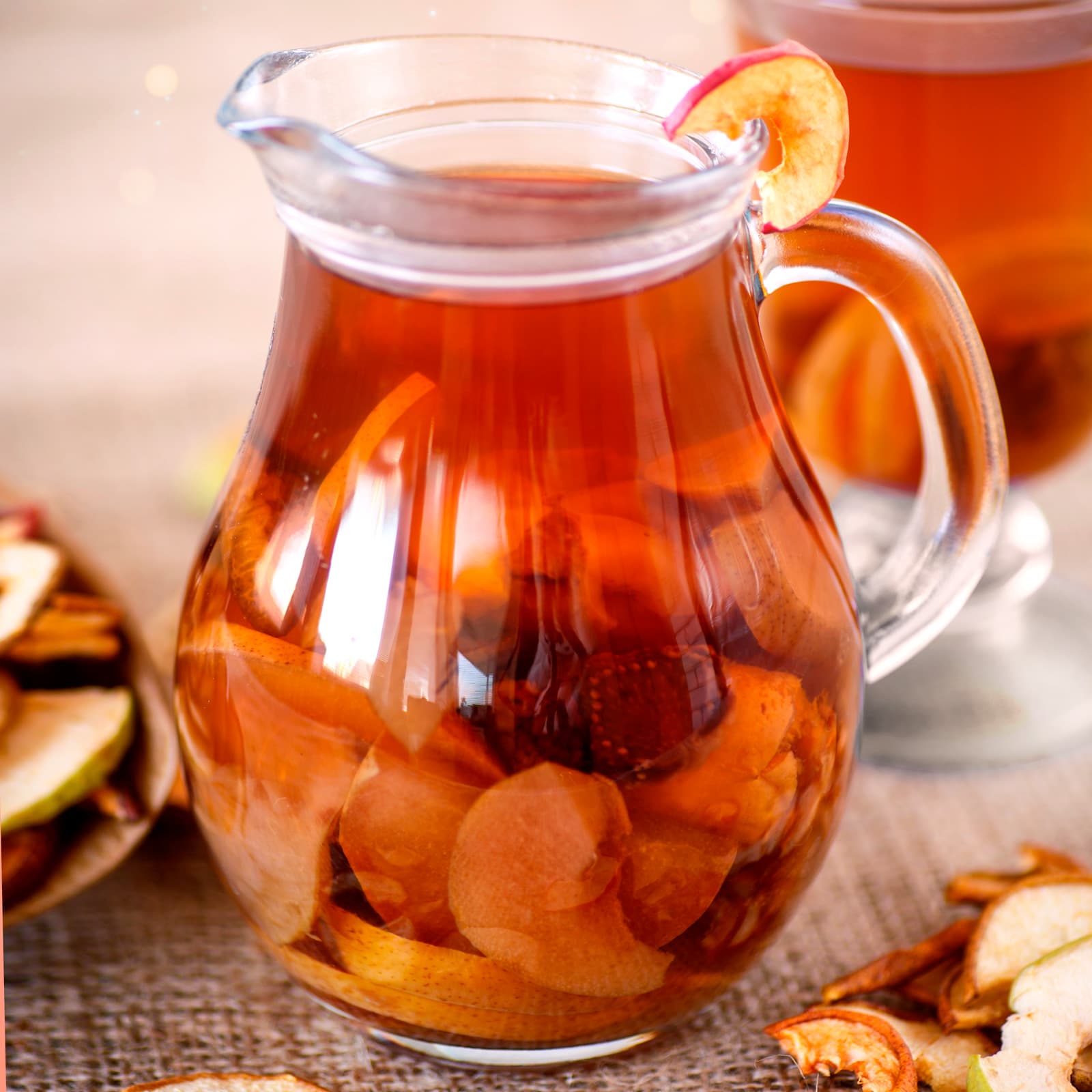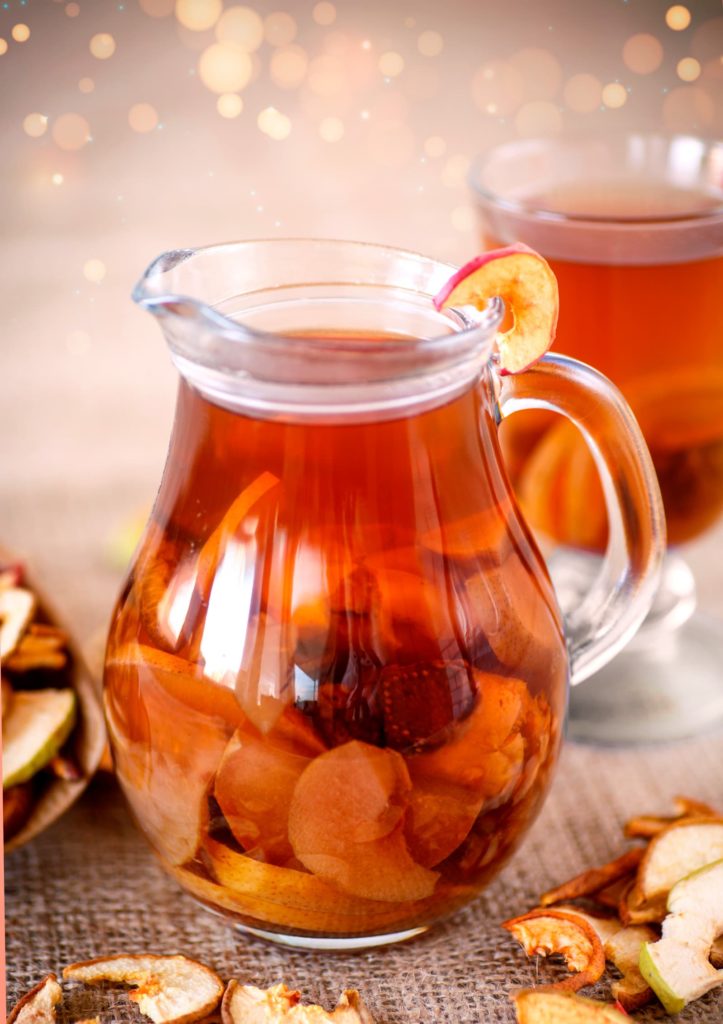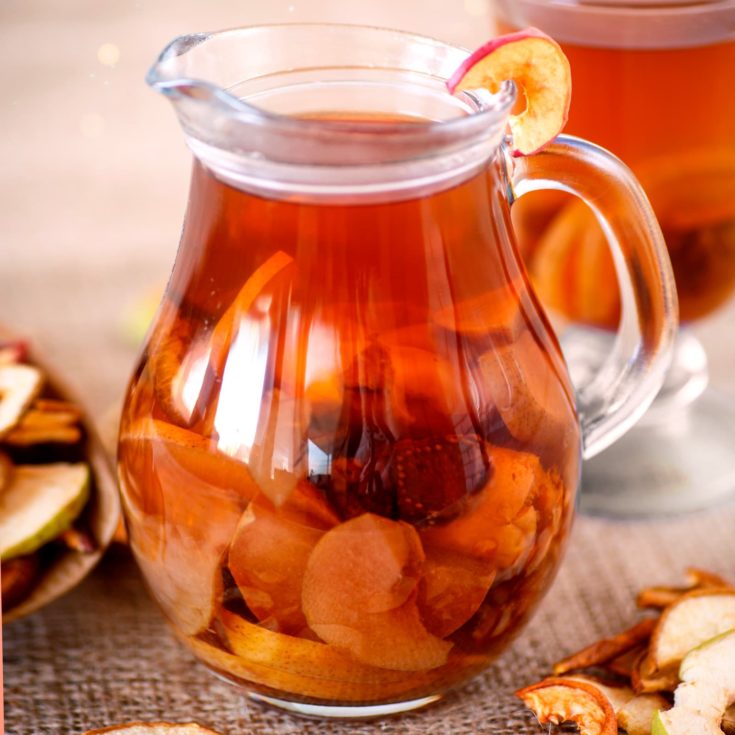Wigilijny Kompot z Suszu
Polish Dried Fruit Compote Drink
How to pronounce it?
compots soo-shoo
‘Play’ to hear:

I’m sure you’ve got some dried fruit stashed at the back of your kitchen cabinet, just begging to be used.
And there’s no better way than by brewing this fragrant Polish-style Dried Fruit Compote, the perfect drink for a festive celebration. Its aroma is a signature smell of Christmas – sweet, musky, woody, and a little bit smoky.
For the full list of ingredients & detailed instructions, please see the recipe card at the end of this post. But before you scroll, there’s important stuff to know below.
Kompot z suszu (pron.: ‘compot s sooshoo’) is a non-alcoholic Polish beverage, traditionally cooked with a variety of dried fruit and spices. On occasion, smoked fruit is used as well.
Good to know: Our Ukrainian neighbours enjoy a similar drink known as Uzvar.
Dried fruits were a very important ingredient in the old-Polish cuisine.
After all, drying and smoking was a great way of preserving the autumn harvest to last throughout winter. These fruits were later used in soups, stews, sauces and desserts.
Do you need any special ingredients or equipment to make this Dried Fruit Compote drink?
Yes, you’ll need to shop around for an array of dried fruit, a pounds-worth (450-500 grams) in total. Make sure they’re not sweetened or candied.
Dried apples and prunes are key here. You can select the rest as you see fit.
🇵🇱 In Poland, dried fruits are available in any major supermarket, some health & drug stores, as well as online. In the time leading to Christmas, grocers sell prepacked dried fruit mixes, ready to be used for a festive kompot.
🌍 Internationally, the availability will depend on your location. If you cannot find any dried fruit at your local supermarket (check the ‘baking’ and ‘snack’ isles as well), try shopping online.
How should you serve this ‘Kompot z Suszu’?
Dried Fruit Kompot can be enjoyed either warm or cold. I serve it chilled, straight from the fridge.
It can be served without straining, together with the fruit still floating around. And while it looks great served this way (especially in a tall glass jug), be mindful that the fruit will loudly ‘plop’ into a glass as you pour it.
To keep your tablecloth clean, I recommend straining kompot first; or pouring it directly into individual glasses for your fellow diners to enjoy.
This recipe makes around 1.5 quarts (1.5 litres) of strong, flavourful kompot. If the taste is too bold for your liking, you can dilute it with water. For a boozy version, add a shot of plain vodka to your glass.
What should you serve with this Dried Fruit Compote?
This drink is a part of nearly every Polish Christmas table. Typically, it’s served alongside an array of festive desserts, such as Makowiec or Kutia. Sometimes it’s even treated as a dessert in its own right, especially when served with fruit.
As I mentioned before, vodka (Polish vodka of course) pairs nicely with the smoky taste of dried fruit. For a festive cocktail, add a shot to your glass of kompot and enjoy.
Can you make this Dried Fruit Compote another way?
Yes, this recipe is open to interpretation. The key ingredients are dried apples and prunes. The rest is up to you, the most popular choices are:
- dried apricots
- dried figs
- dried pears
- dried cranberries
- raisins
All of the above should be dried, without any added sugar. If you have access to smoked fruits, that’s great – add some of them in. Just don’t overdo it, as their taste is much stronger than the regular dried version.
In terms of additional flavourings, the following are suitable:
- citrus zest and/or juice (lemon, orange, lime)
- sugar or mild honey (avoid strong-tasting honeys such as buckwheat or honeydew)
- cloves
- cinnamon sticks
- ginger (root or ground)
- nutmeg (root or ground)
- cardamom
- vanilla pods
How long can you keep this dried fruit compote in the fridge?
Once served, you can keep it out for a while. You can store it in a dark, cool place for up to 2 days.
When storing in the refrigerator, it’s worth covering the container with a lid or cling film, as kompot’s strong aromas tend to penetrate the fridge. I store mine in a tall glass bottle with a stopper. You can keep it chilled for up to 4-5 days.
Can I freeze this ‘kompot z suszu’?
I don’t recommend freezing this recipe. The drink loses its aroma and flavour significantly in the process.

Kompot z Suszu: Polish Dried Fruit Compote Drink

Ingredients
Total of 1-1.1 pounds (450-510 g) mixed dried fruit, for example:
- 5 oz (140 g) dried apples; can be a mix of dried and smoked
- 3 oz (85 g) dried prunes
- 3 oz (85 g) dried apricots
- 3 oz (85 g) dried figs
- 3 oz (85 g) dried pears
- 1 oz (30 g) dried cranberries
- 3 quarts (just under 3 litres) water
- 2 star anise, whole
- 1 small cinnamon stick
- ½ vanilla pod, whole; optional
- 8-10 greed cardamom seeds; optional
- zest of 1 orange; pith-free
- 1 lemon, juiced
- sugar; optional
Decoration:
- fresh orange slices; optional
- fresh rosemary sprigs; optional
Instructions
- Rinse all dried fruit under running water (you can use a sieve). Alternatively, fill a pot with cold water and rinse them there, then pour the water out.
- Add all dried fruit into the pot. Pour the water in.
- [Optional step - soaking the fruit] Cover the pot with a lid and set it aside in a cool place for 12 hours or overnight
- Add in the spices (star anise, cinnamon stick, half of a vanilla pod, cardamom seeds) and orange zest.
- Cover the pot with a lid and bring to boil. Reduce the heat to a minimum and cook for anywhere between 30 and 90 minutes. I believe the longer - the better, but if you don’t have enough time, that’s okay too
- Once the time is up, switch off the heat. Add in the lemon juice and stir. Have a taste - if you enjoy sweeter drinks, now it’s a good moment to add some honey or sugar. Add a single tablespoon at a time, it’s easy to overdo it.
- [Optional step - resting] When the drink cools down, move it to a dark, cool place (e.g. basement, pantry or in a colder climate - terrace or balcony) and leave it there for a few hours, or even overnight. This seems to draw even more flavour from the fruit and the kompot becomes sweeter and thicker.
- [Optional] Drain the contents of the pot. If you don’t mind having your drink WITH the fruit, you can skip this step.
- You’ll end up with approx. just over 3 pints (1.5 quarts, 1.5 litres) of strong, flavourful kompot (the rest of the liquid has evaporated). If it’s too strong for your liking, you can dilute it with water.
- Serve in a tall jug or pour into glasses. Decorate with fresh orange slices and rosemary twigs.
Nutrition Information:
Yield:
7Serving Size:
1Amount Per Serving: Calories: 176Total Fat: 1gSaturated Fat: 0gTrans Fat: 0gUnsaturated Fat: 0gCholesterol: 0mgSodium: 4mgCarbohydrates: 46gFiber: 9gSugar: 31gProtein: 2g
Polonist is reader-supported. When you buy through links on our site, we may earn a small affiliate commission. Learn more
Recipe Information
Filed under:
Alternative traditional/regional names:
Juha
Also known / Misspelt internationally as:
Kampot, Dried Fruit Juice, Dried Fruit Compote, Christmas Kompot
Tested by:
First published on:
Recipe by / Adapted from:
This recipe is a heavily adapted version of Kompot z Suszu recipe by Agnieszka Maciąg, from her “Smak Świąt” cookbook (The Flavour of Christmas), published in 2015, ISBN: 978-83-7515-325-5
Story by:
Bibliography / References: